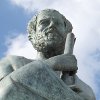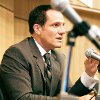Rhetoric, since its Greek origins, has been primarily devoted to the study of the speeches of powerful orators. For centuries, the driving assumption behind rhetorical criticism was that the formal arguments and persuasive appeals located in political discourse acted as primary drivers of politics and history. For the most part, this remained the dominant working assumption of rhetorical critics until the 1980s. During this period, a number of rhetorical scholars, influenced by developments in critical philosophy abroad and political developments in the United States, began to critique the status quo of rhetorical criticism.
Material rhetoric is one product of this critical trend; it embodies an attempt to rethink the nature of public persuasion in a manner capable of capturing the complexity of public persuasion within contemporary culture. Material rhetoric is a specialized approach to conducting rhetorical scholarship, driven by the idea that public persuasion should not be understood as something insubstantial and disembodied — an empty vehicle through which arguments and ideas travel. Perhaps most importantly, material rhetoric rejects the idea that persuasion can be analyzed through textual analysis alone.
While prior rhetorical scholarship had made some overtures to discussing the contexts behind speeches, this was most often practiced through scholarly biographies of rhetors, not rigorous discussions of the exigencies and broader sociopolitical contexts that animate the meaning of the discourse and within which speech produces its effects. Further, rhetorical scholars, in their exclusive focus on speech, had paid little attention to the effects of the rhetorical medium. Rather than the disembodied exchange of ideas, political persuasion is a social process that occurs within a specific cultural context in response to specific occasions or exigencies. Further, rhetoric itself — whether spoken, written, visual, or digital — is physically substantial. Rhetorical appeals are not simply transmitted through a given medium; the medium of persuasion is indissociable from the message.
This article provides an introduction to material rhetoric meant to be useful to prospective graduate students in communication studies. Material rhetoric is a theoretical orientation to rhetoric that attends to the ways in which public persuasion operates within a network of material relations, how political discourse is, itself, a material phenomenon, and how things we typically conceive of as inert material, from city streets to electoral ballots, can, in fact, have important rhetorical consequences.
If, at times, material rhetorical scholarship may seem dauntingly complex, its commitments to understanding the relationship between persuasive discourse and its material context and the significance of the materiality of communication to public persuasion have made it an absolutely vital part of rhetorical criticism. After briefly reviewing the history of material rhetoric and various interpretations of what it means for rhetoric to be material, this article explores three main varieties of materialist scholarship: research focused on the importance of context, criticism that explores the materiality of discourse, and rhetorical criticism interested in how the material operates rhetorically.
A Brief History of Material Rhetoric
During the latter part of the 20th century, a “material turn” took place in a number of humanities and social scientific disciplines. This variety of scholarship was defined by two primary influences; first, the poststructuralist philosophy that became popular in France after the World Wars, emblematized by famed philosophers Jacques Derrida and Michel Foucault; second, a new wave of Marxist scholarship directed at understanding mass culture and popular culture (for a more detailed discussion of this, see the Introductory Guide to Critical / Cultural Studies). These two perspectives are very different, though not necessarily mutually exclusive. The former departs from the assumption that discourse is, itself, a material system that works to produce social reality, while the latter is founded on the premise that language and its uses within culture should be approached primarily as expressions of socioeconomic relations and relations of power.
These positions are alike in a very important way; by conceptualizing discourse as material, both present profound challenges to the Aristotelian model of rhetorical criticism being practiced by scholars when they come onto the scene. That is, for Aristotle, rhetoric is an instrument, deployed with intentionality by orators to engage in political persuasion. Marxism and post-structuralism would both deny the speaker this degree of agency and effectivity; contending that the rhetor’s speech and its persuasive effects are both the product of a larger material dynamics — whether of language or of social relations.
For this reason, the broader turn to materialism creates something of a crisis within rhetorical criticism, producing heated debates concerning how to redefine rhetorical research. Along with *critical rhetoric* material rhetoric has distinguished itself as one of the main attempts to meet these challenges head-on. Material rhetoric represents an attempt to move beyond the Aristotelian paradigm of rhetorical criticism and more rigorously theorize ways in which contexts and power operate persuasively.
This attempt is not only theoretically driven. The shift toward materialism we have discussed so far is, itself, reflective of the cultural struggles of the 1960s and the 1970s, the globalization of liberal democracy in the decades that followed, and the tremendous technological shifts that accompanied them. These changes in culture and context make the old rhetorical models, wherein a rhetor addresses an audience of political equals, with shared cultural backgrounds, via spoken oratory, appear outdated or at the very least incomplete.
Instead, this “postmodern” era is defined by the collapse of overarching narrative truths, what Michael Calvin McGee, one of material rhetoric’s early innovators, calls the “fragmentation of Western culture.” During this period, as critical Geographer David Harvey argues, local cultures are destroyed and transformed, not only through the extension of Western capitalism to all corners of the earth, but through the commodification of cultural differences and its marketing to the West. Material rhetoric is an attempt to reinvent rhetoric for a very different culture than the one in which prior rhetorical methods were formulated.
However, and perhaps unsurprising given this complex and turbulent background, attempts to formulate a material approach to rhetoric have been defined by internal disagreement as to what such an approach should entail. However, despite these turbulent beginnings, materialist research in rhetoric has continued to flourish. A new generation of materialist rhetoric is emerging today, in dialogue with “new materialist” thought, that continues to refine rhetorical approaches to understanding persuasion as a material phenomenon.
Spotlight on Scholarship – Featured Scholars Studying Material Rhetoric
Discover contemporary scholars interested in the materiality of rhetoric, from its relationship with cultural and historical contexts, to the persuasive nature of monuments and the material environments that make up everyday life.
Dr. Dustin W. Edwards is an Assistant Professor and Director of Graduate Programs in the Department of Writing and Rhetoric at the University of Central Florida. His research reflects the important contact points between rhetorical studies and digital technology, focusing on the relationship between digital platforms, rhetorical address, and environmental crisis. His most recent essay “Digital Rhetoric on a Damaged Planet: Storying Digital Damage as Inventive Response to the Anthropocene” was published in Rhetoric Review in 2020. Dr. Edwards is also a frequent collaborator on projects related to the materiality of digital rhetoric. Working with Bridget Gelms, Dr. Edwards has edited a special issue on the rhetoric of platforms for Present Tense: A Journal of Rhetoric In Society, and published articles including “A Technofeminist Approach To Platform Rhetorics.”

Dr. Danielle Endres is Assistant Professor of Communication at The University of Utah. Her scholarship has been important in elaborating what materialist criticism might look like in practice, as reflected in her co-authored article with Aaron Hess, Samantha Senda-Cook and Michael K. Middleton, In Situ Rhetoric: Intersections Between Qualitative Inquiry, Fieldwork, and Rhetoric (2016). This research advocates for participatory methods as an access point into the material contexts that animate rhetoric. Dr. Endres applies this materialist, rhetorical methodology to the study of environmentalism and movements for environmental justice. Her article “Environmental Criticism” appeared in a special issue of the Western Journal of Communication in 2020.

Dr. Laurie Gries is a jointly-appointed Assistant Professor in Communication Studies and Rhetoric and Composition at the University of Colorado Boulder. Dr. Gries’s work on circulation studies and digital research methods have both been important to material rhetoric, helping theorize the rhetorical significance of new media technologies. She is also an important voice in scholarly work on visual rhetoric. Her essays include “The Racial Politics of Circulation,” published in Rhetoric Review, “Advances in Visual Rhetorical Analysis,” published in the SAGE Handbook of Visual Research Methods. Her book Still Life with Rhetoric: A New Materialist Approach for Visual Rhetorics was published in 2015 and was named winner of the 2016 Conference on College Composition and Communication Advancement of Knowledge Award.

Dr. Ersula Ore is a Lincoln Professor of Ethics in The School of Social Transformation and an Associate Professor of African & African American Studies at Arizona State University (ASU). Her research focuses on the rhetoric employed by marginalized communities in the United States after Emancipation. Dr. Ore’s recent journal articles, which discuss the material and spatial politics of racism, include “Lynching in Times of Suffocation: Toward a Spatiotemporal Politics of Breathing,” written with Matthew Houdek and published in Women Studies in Communication, and “Whiteness as Racialized Space: Obama and the Rhetorical Constraints of Phenotypical Blackness.” Dr. Ore’s book, Lynching: Violence, Rhetoric and American Identity was published by the University Press of Mississippi in 2019. At ASU, Dr. Ore teaches courses on rhetoric, race and cultural identity, and oppositional rhetoric.

Dr. Thomas Rickert is Professor of English and Philosophy at Purdue University, whose research specializes in theories of rhetoric, critical / cultural studies, and new media. His 2014 Book Ambient Rhetoric: The Attunements of Rhetorical Being is an important text on the materiality of rhetoric, that theorizes the ways in which humans are enmeshed with their environments, and the consequences this holds for understanding rhetoric. His essays on the materiality of rhetoric span a number of subjects, from digital media to ambient music, and have been published in communication studies journals including Philosophy and Rhetoric.
What is the Material in Material Rhetoric?
The complexity and difficulty of defining rhetoric materially reflects the deeply held nature of the assumptions that materialist rhetoric antagonizes. The most fundamental of these assumptions is called “discursive idealism”: the idea that language, or discourse, constructs our understandings of the world, and the world is, by extension, a product of human understanding. Materialist critics point out that rhetoric’s discursive idealism appears in the Aristotelian paradigm, discussed above, and in the more critically inclined work of ideological criticism and semiotic analysis, as well. There are two main problems with discursive idealism. First, it results in scholarship that acts as if “everything is language,” and omits crucial considerations about context and power (Biesecker 2006). Second, rhetorical scholars of the period tended to focus only on the representations of discourse, and therefore ignored the fact that language and other forms of communication are, themselves, material and have important properties as media.
Materialist criticism, as an alternative to discursive idealism, attempts to address these deficits in two main ways. On the one hand, some materialist critics dedicate themselves to the task of elaborating the relationship between text and context. This was McGee’s (1990) famous contribution to materialist criticism. From McGee’s perspective, given the fractured state of contemporary culture, texts could only be interpreted as fragments operating within complex socio-historical contexts. These critics invest in a more Marxist perspective of the materiality of discourse, which treats it as an expression of the economic and social relations that compose its context. This vein of criticism is discussed in detail in the following section.
On the other hand, there are critics that have received materialism as a call to investigate ways in which discourse and persuasion are, themselves, material. Critics of this persuasion are invested in exploring the “materiality of signification.” Put briefly: in semiotics, communication is made up of a “sign,” which is a composite of the signified (the meaning of the sign), and the signifier (the vehicle that broadcasts the message; the text, image, sound, etc.). Rhetorical scholarship, prior to the interventions of materialism, had been almost exclusively interested in “reading” the textual content of speeches, and had paid little attention to the rhetorical importance of the medium. Materialism has, in this way, inspired scholarly efforts to understand language as a material phenomenon, as well as to understand how material things (like the geography of cities, or the design of social media platforms) are persuasive and communicative in their own right. Both of these subjects are discussed further in the sections below: “The Materiality of Rhetoric” and “Persuasive Materiality.”
Contexts and Class Relations
The first set of perspectives on materialist rhetorical criticism are sometimes called rhetorical materialism. They attempt, in the tradition of Marxist cultural criticism, to locate rhetoric as a reflection or expression of the complex, social relations it emerges within. McGee’s foundational essay “A Materialist’s Conception of Rhetoric” advocates for this type of materialism, in defining rhetoric as a “social process” that emerges from the interplay between audience, speech, change, and occasion, specific to a given cultural, historical context. Rhetorical materialism, from this account, primarily involves reading the relationship between symbolic acts of political communication and their appropriate contexts. It is, more precisely, an analysis of the “specific relationships which ‘speaker/speech/audience/occasion change’ bear to one another in actual human experience” (McGee 1982, in Biesecker and Lucaites, 2006). Rhetoric is interpreted as “part of” a larger social process.
McGee does not deny that rhetoric forms an important element in the political and cultural development of societies; he attributes a substantiality to rhetoric, arguing it is a specific social function that allows for social interaction. It is the effects of this interaction that are truly material, McGee argues, and the texts and speeches one studies as a rhetorical scholar should be treated, not as material unto themselves, but as a “residue” of a larger social dynamic, which can then be used as an entry point to studying the set of relations involved in a particular rhetorical act or event.
This account challenges the dominant Aristotelian paradigm of rhetorical criticism in a number of important ways. It denies speakers the agency of rhetorical invention that scholars typically afforded them, as well as the notion that the political effects of rhetoric could be located in the text alone. Rhetorical materialism offers an alternative to this perspective, by arguing for the study of rhetoric as an important part of the production of culture that, at the same time, is always conditioned within the context of its appearance. McGee’s work has set the stage for critical, materialist work that, following Marx and Foucault, reads rhetoric as a reflection of the dominant economic and social relations operating within a given rhetorical context.
The Materiality of Rhetoric
In the previous section, “rhetorical materialism” is described as a body of scholarship, exemplified by the research of McGee, that aims to understand rhetoric as a social process. This definition of rhetoric as social process, however, importantly retains the idea that language is insubstantial in nature by arguing that its materiality exists in its social use. In contrast, many material rhetorical scholars have been interested in understanding the materiality of rhetoric itself (the ways in which rhetoric is substantial and physically concrete) and unpacking its implications for rhetorical criticism. As Biesecker argues, this tradition of scholarship emerged slightly later, and should be understood as a shift from rhetorical materialism to scholarly interest in the materiality of rhetoric.
One example of this attempt to grapple with the materiality of rhetoric is represented in Ron Greene’s work on rhetoric as a technology. Drawing heavily from Michel Foucault, Greene departs from McGee in arguing for examining the material production of rhetoric as a social process. In particular, Greene advocates for understanding how cultural and power dynamics are involved in the production of rhetorical subjectivity; the particular set of techniques, tactics, and standpoints through which it is possible to engage in public persuasion.
Greene’s work is invested in understanding the historical and contextual specificity of rhetoric, but has a greater focus on the role that power relations play in conditioning rhetorical practice. In defining rhetoric as a technology, Greene emphasizes the ways in which it operates as a social tool, and has particular strategic and functional properties pursuant to that role. This makes rhetoric of great strategic importance. Public speech is thereby regulated by power, through knowledge, norms, and laws, to ensure it falls within acceptable boundaries.
Another thread of research that emerges from this attention to the materiality of rhetoric focuses on the formal features of the discourse, and paying special attention to the signifier or the medium. In this way, contemporary critiques have attempted to come to grips with the material rhetoric of visual media, or digital platforms, or museums, for example, by probing how the physical materiality of these mediums produced unique rhetoric effects.
Persuasive Materiality
Material accounts of rhetoric, as described in the last section, originally retained rhetoric’s focus on language and communication. The animating question of this approach is how to understand discourse materially. Alongside this critical interest, other material rhetorical scholars have taken up the question of how things other than language are rhetorical, or operate persuasively. One major aspect of this materialist criticism has been an interest in how space and place operate rhetorically. Carole Blair, Brian Ott, and Eric Aoki are three of the most influential scholars in this field; their work explores the rhetoric of monuments, memorials, and museums.
This work does not forfeit an interest in context and audience, but is focused on the communicative properties of the material in specific spaces and places. The physical geography of memorials, for example, conditions users’ experience, while their architectural design is capable of meaningful, symbolic acts of communication. For example, the Birmingham Civil Rights Memorial’s reflective exterior surface appears to communicate to visitors a critical vantage on the city around it, casting back an image of the city warped around the memorial’s shape (Blair and Michel, 2000),
For some scholars, including those engaged with “new materialist” perspectives that stress the importance of nonhuman actors in constructing the world, an interest in material rhetoric has also translated into an investment in the rhetoric of material aspects of the world humans do not intentionally use to communicate, or at least not in a traditional sense. Sometimes termed “ambient” or “environmental” rhetoric, criticism of this kind is interested in how apparently noncommunicative, sometimes nonhuman, elements of culture have consequential rhetorical effects (Rickert 2013).
One might think, for example, about the ways in which city design enacts profound effects on how communities are organized: many scholars have argued, for example, urban design contributes to race and class hierarchies in the United States and internationally. Or, one might think of the role that search algorithms play in structuring our encounters with political media before they happen, showing us content we are more likely to consume. In either case, we see evidence of the rhetorical force possessed by material things that are not explicitly communicative.
Material Studies in Rhetoric Today
Three main approaches to understanding the materiality of rhetoric have been discussed in this article: one invested in understanding rhetoric as product of its material context, one interested in how discourse is itself material or a type of technology, and one interested in how that which we typically perceive as non-linguistic or even non-human is rhetorically significant. Each of these perspectives remains important in contemporary rhetorical criticism.
Indeed, in application, the boundaries between these different approaches are often murky. Because most rhetorical criticism is committed to understanding social persuasion, accounts of the material properties of communication must grapple with cultural contexts and their consequences. Contemporary scholarship therefore often blends the concerns of these different critical emphases in order to better capture the different ways in which materiality is rhetorically significant.
While material criticism sometimes pushes into the abstract and the speculative, it does so in order to better capture the cultural and political role that rhetoric plays in today’s world. Contemporary culture is defined by both an intensification of political persuasion that operates through non-linguistic media (often even below the level of cognition, and certainly below the level of rational communication) and the erosion of public discourse as an effective agency of governance.
These changes have demanded a substantial rethinking of the Aristotelian rhetoric paradigm. This rethinking is still in-progress in the present moment, and will likely remain so as the social contexts underlying rhetorical practice continue to shift. This is, in the end, one of material rhetoric’s most important takeaways: that rhetoric is always open to change as the material dynamics which occasion its emergence shift, whether through changes in the mediums through which we communicate or in the cultural contexts in which communication occurs.
Sources and Additional Resources
To learn more about material rhetoric or dig deeper into the scholarship discussed above, check out the following texts.
- Blair, Carole. 1999. “Contemporary U.S. Memorial Sites as Exemplars of Rhetoric’s Materiality,” in Rhetorical Bodies. Jack Selzer and Sharon Crowley, eds. University of Wisconsin Press, 16-57.
- Blair, Carole. 2001. Reflections on Criticism and Bodies: Parables From Public Places. Western Journal of Communication 65: 271-294.
- Blair, Carole. 2012. “Visiting the Past Rhetorically: Places of Public Memory,” in Communication Studies: Translating Communication Scholarship into Meaningful Practice, eds. Alan K. Goodboy and Kara Schulz, eds. Kendall/Hunt: 379-391.
- Blair, Carole, and Neil Michel. 2000. Reproducing Civil Rights Tactics: The Rhetorical Performances of the Civil Rights Memorial. Rhetoric Society Quarterly 30: 31-55.
- Biesecker, Barbara and John Lucaites, eds. 2009. Rhetoric, Materiality, and Politics. Peter Lang.
- Biesecker, Barbara A. 2002. Remembering World War II: The Rhetoric and Politics of National Commemoration at the Turn of the 21st Century. Quarterly Journal of Speech 88(4): 393–409. https://doi.org/10.1080/00335630209384386.
- Boyle, Casey. 2015. The Rhetorical Question Concerning Glitch. Computers and Composition Vol. 35: pp. 12-29.
- Boyle, Casey and Nathaniel Rivers 2018.. “Augmented Publics” in Circulation, Writing, and Rhetoric, Laurie Gries and Collin Brooke, eds. University of Alabama Press.
- Cloud, Dana L. 1994. The Materiality of Discourse as Oxymoron: A Challenge to Critical Rhetoric. Western Journal of Communication 58(3):141–63. https://doi.org/10.1080/10570319409374493.
- Dickinson, Greg, Carole Blair, and Brian L. Ott, eds. 2010. Places of Public Memory: The Rhetoric of Museums and Memorials. University of Alabama Press.
- Edwards, Dustin W. 2020. Digital Rhetoric on a Damaged Planet: Storying Digital Damage as Inventive Response to the Anthropocene. Rhetoric Review 39(1): 59–72. https://doi.org/10.1080/07350198.2019.1690372.
- Endres, Danielle, and Samantha Senda-Cook. 2011. Location Matters: The Rhetoric of Place in Protest. Quarterly Journal of Speech 97(3): 257-282.
- Greene, Ronald Walter. 1998. Another Materialist Rhetoric. Critical Studies in Mass Communication 15(1)): 21–40. https://doi.org/10.1080/15295039809367031.
- Greene, Ronald Walter. 2010. Spatial Materialism: Labor, Location, and Transnational Literacy. Critical Studies in Media Communication 27(1): 105-110.
- Kennerly, Michele and Damien Pfister. 2018. “Introduction” in Ancient Rhetorics and Digital Networks. Tuscaloosa: University of Alabama Press: 1-27.
- La Gries, Laurie. 2015. Still Life with Rhetoric: A new materialist approach for visual rhetorics. Boulder: University Press of Colorado.
- Lundberg, Christian. 2012. Lacan in Public. Tuscaloosa: University of Alabama Press.
- Lundberg, Christian. 2013. Letting Rhetoric Be: On Rhetoric and Rhetoricity. Philosophy and Rhetoric 46(2): 247-255.
- Lundberg, Christian and Joshua Gunn. 2005. Ouija board, are there any communications? Agency, ontotheology, and the death of the humanist subject, or, continuing the ARS conversation. Rhetoric Society Quarterly 35(4): 83-105.
- Maurantonio, Nicole. 2015. Material Rhetoric, Public Memory, and the Post-It Note. Southern Communication Journal 80(2): 83–101. https://doi.org/10.1080/1041794X.2015.1011344.
- McGee, Michael Calvin. 1980. “The ‘Ideograph’: A Link between Rhetoric and Ideology.” Quarterly Journal of Speech 66(1): 1-16.
- McGee, Michael Calvin. 1990. “Text, Context, and the Fragmentation of Contemporary Culture.” Western Journal of Communication 54(3): 274-289.
- McKerrow, Raymie E.1989 “Critical rhetoric: Theory and praxis.” Communications Monographs 56(2): 91-111.
- Muckelbauer, John. 2008. The Future of Invention: Rhetoric, Postmodernism, and the Problem of Change. State University of New York Press.
- Ott, Brian L, and Greg Dickinson. 2019. Redefining Rhetoric: Why Matter Matters 3(1): 38.
- Pfister, Damien Smith. 2014. Networked media, Networked Rhetorics: Attention and Deliberation in the Early Blogosphere. Penn State Press.
- Rickert, Thomas. 2013. Ambient Rhetoric: The Attunements of Rhetorical Being. University of Pittsburgh Press.
- Saussure, Ferdinand. 1959. Course on General Linguistics. University of Columbia Press.
- Wanzer, Darrel Allan. 2012. Delinking Rhetoric, or Revisiting McGee’s Fragmentation Thesis through Decoloniality. Rhetoric and Public Affairs 15(4): 647-65.
Additional Topics on Research in Rhetorical Studies

This guide provides an in-depth discussion of rhetorical studies, describing the history and significance of the discipline while also providing readers with theories that are useful to understanding different forms of rhetoric and their functions in human communication.

This article discusses the field of critical rhetoric and its importance in the examination and exposure of power dynamics in society. It also provides information on key scholars in the field who study how rhetoric connects to equality, politics, and cultural values.

This detailed article discusses the history and forms of gender criticism in rhetorical studies, and also explains the political, social, and cultural significance of this field of study.

This article provides an overview of genre criticism in rhetorical studies, and how it has evolved over the centuries. It also explains the influential work of scholars in this field of study.

This article explains how metaphors are widely used in human communication and understanding, and provides a background on the history and prominent scholarship of this field.

This article covers narrative criticism and the role it plays in culture, politics, and relationships, while also providing examples of prominent scholarship in this field.

Learn about scholarly efforts to understand how communities come to share perceptions about the past and explore the different rhetorical strategies employed in constructing public memory, from monuments to new media.

This article examines the history and impact of social movement rhetorical research, and provides readers with a detailed overview of some of the latest research in the field that is being completed by eminent scholars of social justice and civil rights rhetoric.


